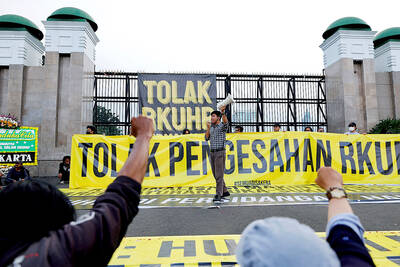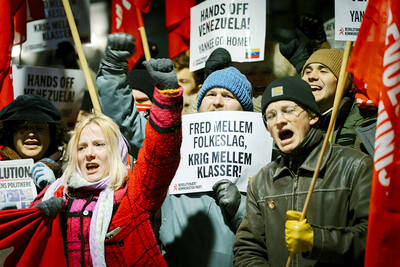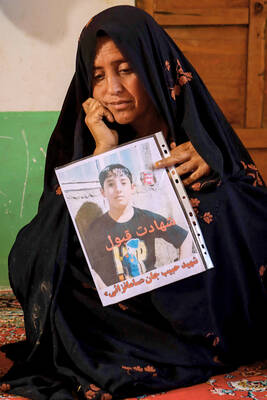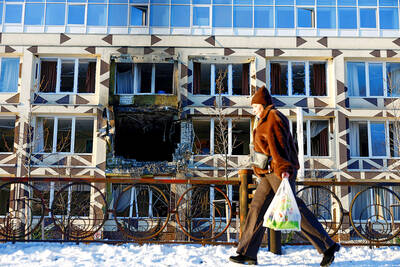"I am afraid," one prisoner awaiting interrogation and almost certain death at the hands of the Gestapo scrawled on the walls of his Paris prison cell.
"Never confess," reads another defiant message etched into the plaster nearby.
Heart-rending words transformed by history into epitaphs, these and other messages on long-forgotten walls in the Gestapo's World War II Paris headquarters went on exhibit for the first time ever over the weekend, part of France's annual heritage day.
More than 15,000 sites normally closed to the public, ranging from the national archives to the finance ministry, opened their doors to some 10 million visitors on Saturday and yesterday.
Most of the rooms at 11, rue de Saussaies in the 8th arrondissement were renovated after the French interior ministry took possession of this notorious address where hundreds, if not thousands, of resistance fighters and other hapless victims of the Nazi occupation were tortured and condemned to die.
It was as if France's post-war leaders were eager to turn a page.
But a few prison cells were left untouched, and the plaintiff expressions of fear and foreboding, patriotism and pride, preserved on their walls stand today as a moving testament of Gestapo cruelty and human defiance.
"Frankreich ueber alles" -- "France above all" -- reads on inscription with biting irony, a play on words transforming the title of the German national anthem.
"Believing in yourself gives one the power to resist despite the bathtub and all the rest," reads another, a dark allusion to a preferred technique of torture practiced by the Gestapo.
"Don't talk," commands another, as if to give courage.
Most of the unfortunates interrogated and tortured here were later executed or deported to camps, historians say.
The few rooms that remain from that era have been left intact: the ceiling lamp that still casts a wan, sinister light over the room; the thick metal ring attached to the wall, to which prisoners were chained; the barred window with a view of the interrogation chambers on the other side of the courtyard.
The prisoner graffiti -- written with bits of lead or pencils hidden in shirt collars, or simply carved with any sharp object at hand -- is today protected by glass barriers.
Many of those detained here had no illusions as to their destiny. "Julien. 20 years old. Headed for the post," reads one, referring to the wooden poles to which prisoners were attached before being executed by firing squad.
"Labiscotte. Arrived June 8, 1944. For liberty of for death?" reads another, still daring to hope.
And yet another: "Honored to be condemned by the Bosh. Goodbye forever to France and my loved one," it says, using a common name for Germans during the war.
Some inscriptions are like diary entries: "Marcel is thinking of Simone and Kiki"; "Guillaume loves Marianne"; "I cannot sleep for thinking about my parents and my beloved Louisette."
Other parts of the walls are like bulletin boards, with messages the authors hoped would, somehow, find their way to intended recipients. "Roger: your father, your cousin and Colette's father came through here 24-5-44."
There are even expressions of optimism -- "We will be free by Christmas 1944" -- and philosophical resignation: "Life is beautiful."
United in their misery, one finds the hammer-and-sickle emblem of communism next to Christian prayers. "My God I want, All that you want, Because you want it, As you want it, As much as you want it," reads one.
The walls were also common ground for the barely literate and the highly cultivated, such as Yvette Marie-Jo Wilbort who -- not daring to imagine that she would live to see the war's end -- quoted from memory, for her epitaph, a verse from a poem by Alfred de Vigny.
"Wailing, pleading, crying -- these are the coward's call. Assume your heavy and onerous burden, the one that fate has cast your way. And then, like me, suffer and die in silence."
Wilbort survived, one of the few.

Indonesia yesterday began enforcing its newly ratified penal code, replacing a Dutch-era criminal law that had governed the country for more than 80 years and marking a major shift in its legal landscape. Since proclaiming independence in 1945, the Southeast Asian country had continued to operate under a colonial framework widely criticized as outdated and misaligned with Indonesia’s social values. Efforts to revise the code stalled for decades as lawmakers debated how to balance human rights, religious norms and local traditions in the world’s most populous Muslim-majority nation. The 345-page Indonesian Penal Code, known as the KUHP, was passed in 2022. It

‘DISRESPECTFUL’: Katie Miller, the wife of Trump’s most influential adviser, drew ire by posting an image of Greenland in the colors of the US flag, captioning it ‘SOON’ US President Donald Trump on Sunday doubled down on his claim that Greenland should become part of the US, despite calls by the Danish prime minister to stop “threatening” the territory. Washington’s military intervention in Venezuela has reignited fears for Greenland, which Trump has repeatedly said he wants to annex, given its strategic location in the arctic. While aboard Air Force One en route to Washington, Trump reiterated the goal. “We need Greenland from the standpoint of national security, and Denmark is not going to be able to do it,” he said in response to a reporter’s question. “We’ll worry about Greenland in

PERILOUS JOURNEY: Over just a matter of days last month, about 1,600 Afghans who were at risk of perishing due to the cold weather were rescued in the mountains Habibullah set off from his home in western Afghanistan determined to find work in Iran, only for the 15-year-old to freeze to death while walking across the mountainous frontier. “He was forced to go, to bring food for the family,” his mother, Mah Jan, said at her mud home in Ghunjan village. “We have no food to eat, we have no clothes to wear. The house in which I live has no electricity, no water. I have no proper window, nothing to burn for heating,” she added, clutching a photograph of her son. Habibullah was one of at least 18 migrants who died

Russia early yesterday bombarded Ukraine, killing two people in the Kyiv region, authorities said on the eve of a diplomatic summit in France. A nationwide siren was issued just after midnight, while Ukraine’s military said air defenses were operating in several places. In the capital, a private medical facility caught fire as a result of the Russian strikes, killing one person and wounding three others, the State Emergency Service of Kyiv said. It released images of rescuers removing people on stretchers from a gutted building. Another pre-dawn attack on the neighboring city of Fastiv killed one man in his 70s, Kyiv Governor Mykola